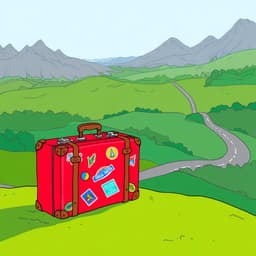Have a good trip
in Spanish¡Buen viaje!
/BWEN vee-AH-heh/
This is the most direct, common, and universally understood way to wish someone a good trip. It's the perfect, all-purpose phrase that works in any situation, from formal to casual.

Wishing someone '¡Buen viaje!' is a warm and common gesture before they depart on a journey.
💬Other Ways to Say It
¡Que tengas un buen viaje!
/keh TEN-gahs oon BWEN vee-AH-heh/
A slightly longer, more personal version that literally means 'May you have a good trip'. Using 'tengas' makes it informal and warm.
¡Que tenga un buen viaje!
/keh TEN-gah oon BWEN vee-AH-heh/
This is the formal version of the phrase above, using 'tenga' for 'usted' (the formal 'you'). It conveys respect and politeness.
¡Feliz viaje!
/feh-LEES vee-AH-heh/
Literally 'Happy trip!'. It's a cheerful and positive alternative to '¡Buen viaje!' and is used in exactly the same way.
¡Que te vaya bien!
/keh teh VAH-yah bee-EN/
This means 'May it go well for you!' or 'Hope it goes well!'. While not specific to travel, it's an extremely common way to wish someone well as they are leaving for a trip or any other endeavor.
¡Que le vaya bien!
/keh leh VAH-yah bee-EN/
The formal version of '¡Que te vaya bien!'. It's a polite and respectful way to wish someone well as they depart, suitable for any formal interaction.
¡Disfruta tu viaje!
/dees-FROO-tah too vee-AH-heh/
A direct and friendly translation of 'Enjoy your trip!'. This phrase specifically emphasizes the pleasure and fun of the journey.
¡Disfrute su viaje!
/dees-FROO-teh soo vee-AH-heh/
The formal way to say 'Enjoy your trip!', using 'disfrute' and 'su' for 'usted'. It's common in the service industry.
🔑Key Words
Key Words to learn:
📊Quick Comparison
Here’s a quick guide to help you choose the best phrase for wishing someone a good trip based on the situation.
| Phrase | Formality | Best For | Avoid When |
|---|---|---|---|
| ¡Buen viaje! | Neutral | Any situation. It's the universal, can't-go-wrong option. | Never. It's always a good choice. |
| ¡Que tengas un buen viaje! | Informal | Adding a personal, warm touch with friends and family. | In very formal settings or with people you address as 'usted'. |
| ¡Que tenga un buen viaje! | Formal | Showing respect to elders, clients, or strangers. | With close friends, where it might sound a bit stiff. |
| ¡Feliz viaje! | Neutral | A cheerful, upbeat alternative to '¡Buen viaje!'. | Never, it's a friendly and safe option for any context. |
| ¡Que te vaya bien! | Informal | A general, friendly farewell when someone is leaving for a trip or any other activity. | When you specifically want to mention the 'trip' itself. |
📈Difficulty Level
Fairly easy. The main challenge is the Spanish 'j' in 'viaje', which is a soft, breathy 'h' sound from the back of your throat, like the 'h' in 'hello'.
The basic phrase '¡Buen viaje!' has no grammar. Variations require choosing between informal ('tengas') and formal ('tenga'), which is a key concept in Spanish.
The usage is very straightforward and aligns closely with English customs. It's a universally positive and safe expression.
Key Challenges:
- Pronouncing the 'j' sound in 'viaje' correctly.
- Remembering to use 'tengas' for friends and 'tenga' for formal situations.
💡Examples in Action
Nos vemos en dos semanas. ¡Que tengas un buen viaje a Perú!
See you in two weeks. Have a good trip to Peru!
Gracias por su estancia con nosotros, señor. ¡Que tenga un buen viaje de regreso a casa!
Thank you for your stay with us, sir. Have a good trip back home!
Mi avión sale en una hora. — ¡Vale, buen viaje! Mándame un mensaje cuando llegues.
My plane leaves in an hour. — Okay, have a good trip! Send me a message when you arrive.
Me voy de fin de semana a la playa. — ¡Qué bien! ¡Feliz viaje!
I'm off to the beach for the weekend. — That's great! Happy travels!
🌍Cultural Context
The Warmth of Well-Wishes
In many Spanish-speaking cultures, wishing someone well on a journey is more than just a polite formality; it's a genuine expression of care. These phrases are often said with warmth and sincerity, and frequently accompanied by a hug, a handshake, or kisses on the cheek, depending on the relationship.
A Universal Gesture
Unlike some expressions that vary wildly by country, '¡Buen viaje!' is remarkably universal. Whether you're in Madrid, Mexico City, or Buenos Aires, this phrase will be perfectly understood and appreciated. It's one of the safest and most useful phrases a traveler can learn.
Beyond the Trip Itself
Phrases like '¡Que te vaya bien!' ('Hope it goes well!') are incredibly versatile. While perfect for a trip, you'll also hear them when someone is leaving for a new job, an important meeting, or even just heading home for the day. It's a general-purpose 'good luck and be well' expression.
❌ Common Pitfalls
Using 'Tener' as a Command
Mistake: "Learners sometimes try a direct translation like 'Ten un buen viaje'."
Correction: ¡Que tengas un buen viaje! or ¡Buen viaje!
Mixing Formality
Mistake: "Saying something like '¡Que tenga tu buen viaje!' to a friend."
Correction: ¡Que tengas un buen viaje!
Using 'Viaje' for Any 'Trip'
Mistake: "Telling someone '¡Buen viaje!' when they are just going to the grocery store."
Correction: ¡Que te vaya bien!
💡Pro Tips
Choose Your Level of Warmth
Use '¡Buen viaje!' as your reliable default. Use '¡Que tengas un buen viaje!' when you want to add a bit more personal warmth for a friend or family member. Both are excellent choices.
Add a Follow-Up
To sound even more natural, you can add another friendly phrase. For example: '¡Buen viaje! ¡Cuídate mucho!' (Have a good trip! Take good care!) or '¡Buen viaje! ¡Nos vemos a la vuelta!' (Have a good trip! See you when you get back!).
How to Respond
If someone wishes you a good trip, a simple '¡Gracias!' or '¡Muchas gracias!' is the perfect response. You can add '¡Igualmente!' (You too!) if they are also traveling or as a general kind gesture.
🗺️Regional Variations
Spain
The well-wishes are common and sincere. Depending on the relationship, it's often accompanied by two kisses on the cheeks ('dos besos') as a farewell gesture.
Mexico
Mexicans are known for their warmth and friendliness. Wishing someone a good trip is a very common courtesy and is always appreciated. The phrase '¡Que te vaya muy bien!' is extremely frequent.
Argentina
Argentinians might add 'che' to make it more familiar, as in '¡Buen viaje, che!'. The term 'rebién' is a common intensifier meaning 'really well'.
💬What Comes Next?
You tell a friend you are leaving for a trip tomorrow.
¡Qué bueno! ¿A dónde vas?
That's great! Where are you going?
Voy a [destino]. ¡Estoy muy emocionado/a!
I'm going to [destination]. I'm very excited!
Someone wishes you '¡Buen viaje!'.
¡Buen viaje!
Have a good trip!
¡Muchas gracias! Te llamo cuando llegue.
Thank you very much! I'll call you when I arrive.
After you thank them for the well-wishes.
De nada. ¡Disfruta mucho!
You're welcome. Enjoy it a lot!
¡Claro que sí! ¡Hablamos pronto!
Of course! Talk soon!
🧠Memory Tricks
This direct connection to the English word 'voyage' makes 'Buen viaje' easy to remember as a travel-related phrase.
Connecting 'feliz' to a well-known holiday greeting helps solidify its meaning as 'happy', making the phrase easy to recall.
🔄How It Differs from English
The biggest difference is the common Spanish structure 'Que + [verb]' to express a wish (e.g., 'Que tengas...'). English doesn't have a direct, everyday equivalent; we just state the wish ('Have a good trip'). This 'Que' structure is a key pattern for expressing hopes and desires in Spanish.
Both English and Spanish expressions are equally direct and polite. '¡Buen viaje!' is a straightforward, positive statement, just like 'Have a good trip'.
🎯Your Learning Path
➡️ Learn Next:
How was your trip?
This is the natural question to ask someone when they return from their journey.
Welcome back
A perfect and friendly greeting for someone who has just returned from a trip.
Take care
A common and caring phrase to add after wishing someone a good trip.
Where are you going?
A logical question to ask before someone leaves, prompting the need to wish them a good trip.
✏️Test Your Knowledge
💡 Quick Quiz: Have a good trip
Question 1 of 3
You are at a hotel, and the receptionist, who has been very formal with you, is checking you out. What is the most appropriate way to wish her well as you leave?
Frequently Asked Questions
What's the real difference between '¡Buen viaje!' and '¡Que tengas un buen viaje!'?
'¡Buen viaje!' is a concise, all-purpose statement like 'Good trip!'. '¡Que tengas un buen viaje!' is a more complete sentence, 'May you have a good trip!'. It feels slightly more personal and warmer, but both are completely correct and used constantly.
Is it rude or too simple to just say '¡Buen viaje!'?
Not at all! '¡Buen viaje!' is perfectly polite, common, and friendly. It's the standard way to say it and is never considered rude or overly simple. Your tone of voice will convey the warmth.
How do I respond if someone says '¡Buen viaje!' to me?
A simple and warm '¡Gracias!' or '¡Muchas gracias!' is the perfect response. You don't need to say anything more, but you could add something like '¡Hablamos pronto!' (Talk soon!).
Can I use 'viaje' for a short trip, like going to another city for the day?
Yes, absolutely. A 'viaje' is a journey, and a day trip to another city definitely counts. You would not use it, however, for a quick trip to the local store or a friend's house across town.
What's the difference between 'Que te vaya bien' and 'Buen viaje'?
'¡Buen viaje!' is specifically about the trip itself. '¡Que te vaya bien!' is more general, meaning 'Hope it goes well for you'. You can use it for a trip, but also for someone going to a job interview, a doctor's appointment, or just heading home. It's a broader well-wish.
Should I use the tú (tengas) or usted (tenga) form?
Use the 'tú' form ('que tengas') with people you know well, people your age or younger, friends, and family. Use the 'usted' form ('que tenga') with strangers, older people, in professional settings, and with anyone you want to show a higher level of respect.
📚Continue Learning Spanish Phrases
Explore More Phrases in These Categories
Find similar phrases to expand your Spanish vocabulary:
Want to Learn More Spanish Phrases?
Browse our complete collection of Spanish phrases organized by situation, from basic greetings to advanced conversations. Perfect for travelers, students, and anyone learning Spanish.
View All Spanish Phrases →




